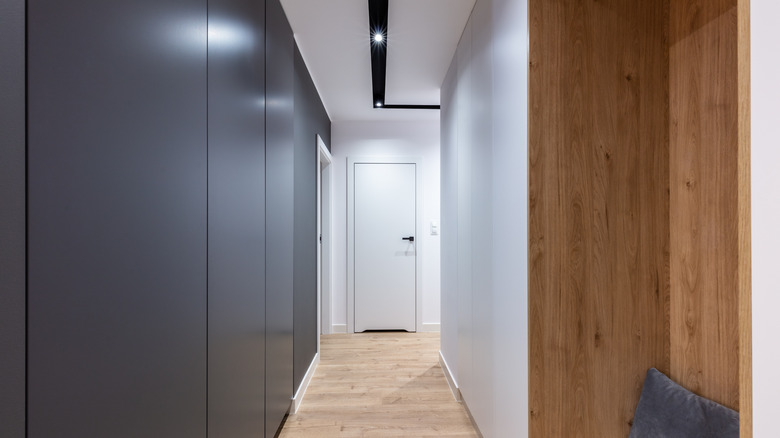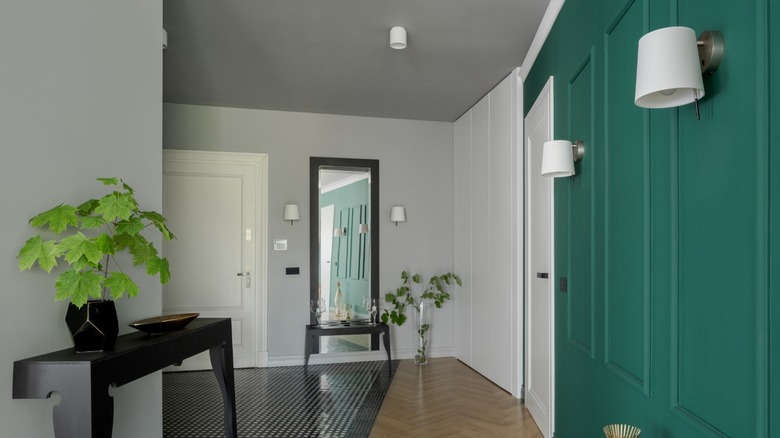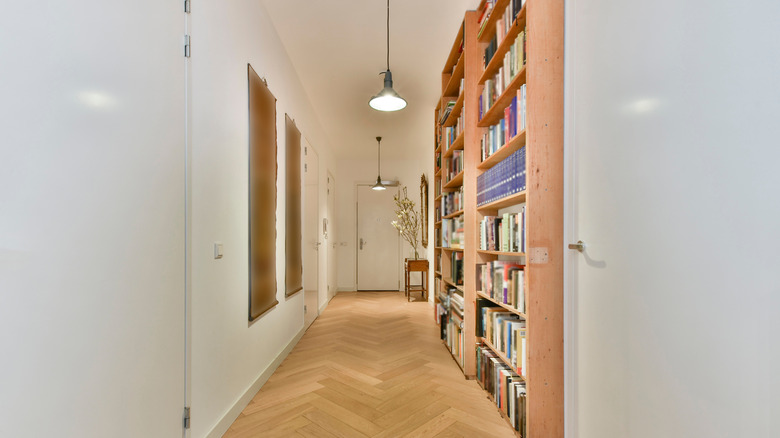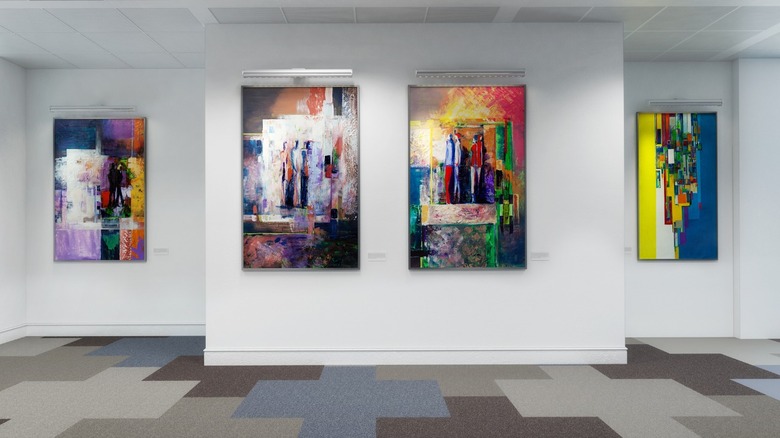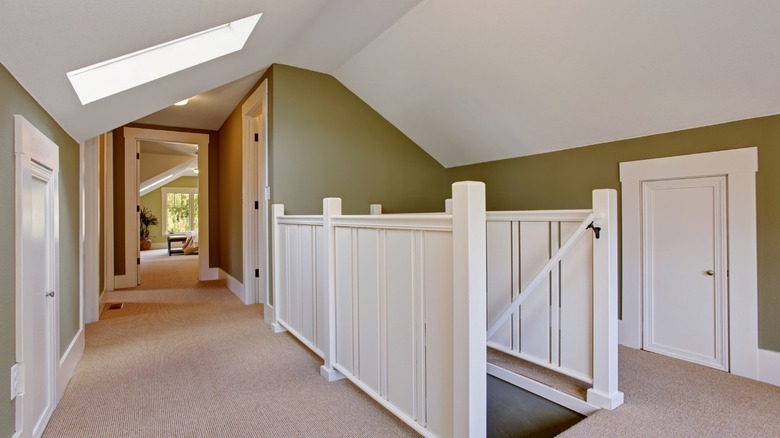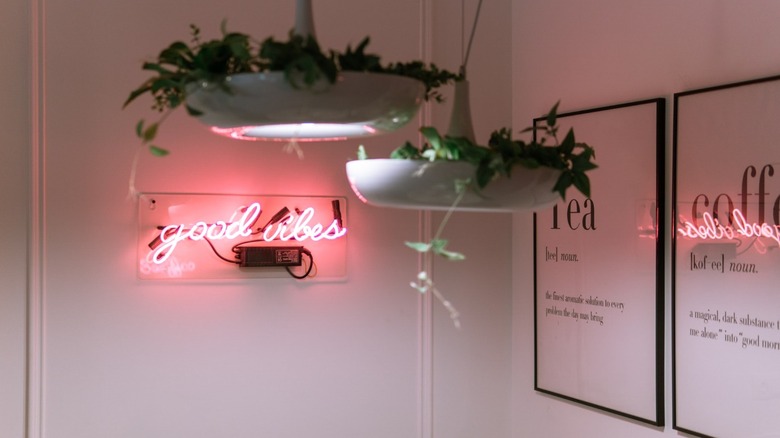Creative Ways To Use Lighting In A Hallway Without Windows
If your home doesn't have a completely open concept floor plan, that means it has hallways. Possibly straight, short, long, narrow, or meandering. All of those are fine, and probably the least preferred are the dim and dark ones. You may have purchased a house without ample lighting and windows in its corridors. Perhaps, you built a new home and neglected to give them enough consideration, or you rented and are paying for someone else's design mistakes. Whatever the case, you find yourself roaming lackluster halls that are far from illuminating. There are a few tricks that will help brighten dark spaces, such as adding mirrors and covering walls in a high-gloss paint finish to reflect light. Or you could opt to play up the drama of a dim and intimate passage with rich color or patterned wallpaper.
Yet, not much has the brilliance and equivalence of adding light fixtures. We've gathered several ideas below, most with options for any look and budget, skipping the customary track and recessed treatments for some alternate options. They can be used alone or layered to greater effect; combining ambient (general) and accent (focused) lighting makes the space feel less cavernous, according to LampShopOnline. To enhance the mood further, install dimmers or, per American Home Shield, use specialty bulbs in conjunction with a smartphone app for brightness and color control. Even the absence of wiring can't stop you, and your halls will feel safer, stylish, and visible.
Sconces
In addition to their function, sconces add a lot of flair to any space. They keep the ceiling free of hanging fixtures, which is important for homes with low ceilings — more on that next. They punctuate the environment along the hallway in strategic locations to provide both ambient and accent lighting, as well as call attention to architectural features, wallpaper, or art. As pictured, they highlight an entry mirror and the emerald-painted picture frame molding. In this example, the fixtures are the same, creating cohesion and helping to tie the green section of the wall to the rest of the space. But in another home, they could very well be coordinating or complementary to each other. There are unlimited styles and a variation of sizes and price points available to support your décor and budget.
Sconces can be combined with overhead lighting in the form of recessed or track fixtures, pendants, chandeliers, or even string lights for a cumulative effect. Emily Henderson notes the best height for them is eye level, though they can be adjusted for high ceilings. The Knowledge Burrow explains that sconces can be controlled individually or from a wall switch. If you want to hard-wire them in, which means there are no visible cords and they are permanently connected to the electrical system, expect to pay an electrician approximately $400 per pair of sconces. They further suggest installing a dimmer, while LampShopOnline recommends warm colors to create an inviting mood.
Pendants
Per CrystoramaStyle, the functionality should be the primary focus in a hallway lighting plan, yet there is an abundance of fixture options for pleasing and stylish spaces. Consider the drama of chandeliers and pendants if the ceiling is higher than standard or fixture placement won't interfere with traffic and door clearance. Match existing design elements in the materials for a coordinated look, go bold and express your personality with something eye-catching, or select ghost pieces in lucite or glass for a subtle effect. According to the decorative lighting purveyor, hanging fixtures make a statement, help to create a focal point, and pull the eye up to enhance the impression of height. Furthermore, Litecraft notes that illuminating the ceiling will make the area feel more open and expansive.
You can add just one central piece, supporting it with accent lighting, or place multiple fixtures throughout the corridor — putting them on a dimmer will maximize control over brightness. HomeWyse reports that hard-wiring and installation of one pendant can total $500 on average, noting that several factors will affect labor costs. However, per Design Morsels, hard wiring isn't essential if the budgetary or living situation doesn't permit it. Plug-in models and swag fixtures can be secured with hooks and connected to an outlet. The fixture cord is often woven through an attractive chain or can be made more discreet with a cable concealer. If it's too short of reaching the outlet, it can be extended with a wire kit.
Picture lights
TLC Interiors proposes hanging and lighting art as a perfect way to upgrade hallway space. According to MasterClass, sunlight can cause heat damage and threaten the stability of the materials in a photograph or artwork. Therefore, a corridor without windows may be the ideal location to display a collection. The intentional placement creates a gallery feeling in your own home, while the lighting fixtures add the benefit of illuminating the passage. For a straight hall with no obstacles and little need for bright lighting, consider allowing the atmospheric, low-level light and the art to remain the focus. If safety requires additional types of fixtures, the dramatic effect of the showcased art pieces will still be experienced. Glimpsed from another room, they will draw or stop the eye, manipulating the visual flow through the space.
Lamps Plus notes that there are several kinds and sizes of picture lights. Typically they are either wall or frame-mounted; in addition, there are direct-wire, plug-in, and battery-operated models. LEDs may provide the best bulb options because they don't emit damaging UV rays and change the colors in the artwork the least. The lamp stockist explains that the width of the picture light is determined by the dimensions of the framed piece, while it's generally recommended the beam should be focused on the center at a 30-degree angle.
Faux skylights
Skylights are an attractive feature, bringing the sun or clouds indoors. And though it would certainly brighten things up, we're not recommending you start cutting holes in your ceiling. Artificial skylights mimic natural sunlight via color-changing LED lights and panels, according to Gizmodo. The technology targets commercial uses, such as office settings and warehouses that receive little to no natural light but could also be valuable in healthcare applications. Per the Smithsonian Magazine, the innovation imitates the natural sunlight conditions of color temperature and strength so closely it's able to trick both the human brain and a camera. These systems require a large space and can cost anywhere from $6,800 to $68,000.
At home, the idea is referenced on a smaller scale with affordable LED panel lights. ElectronicsHub explains that they're a suitable replacement for fluorescent fixtures. They emit brighter light, are more energy efficient, and are much sleeker than the typical housing for fluorescent bulbs. The organization notes that it's usual for every LED panel to be equipped with a dimming capability. They provide diffuse lighting while their flush-mount installation makes them ideal for low ceilings.
Neon
Neon is a perfect blend of mood and expression — a soft and atmospheric glow combined with an artful way to fill a blank wall. Per Neon Creations, it contributes a contemporary and unexpected component to the décor that can act as a focal point while also providing light in dim corners and hallways. The company explains that neon incorporates 360-degree lighting, which means the slim and delicate tubes are lit from all angles.
Installations can be created in numerous colors and backgrounds, from wood to metal to barely-there acrylic, or fastened directly to the wall, perhaps offering the most custom look. Choose the saying, font style, and size for a completely personal statement. HowMuchIsIt reports that a pre-made sign is typically between $50 and $200, while a custom piece may be more than $2,000. If you're searching for a unique nightlight, neon could be a delightful dream.
